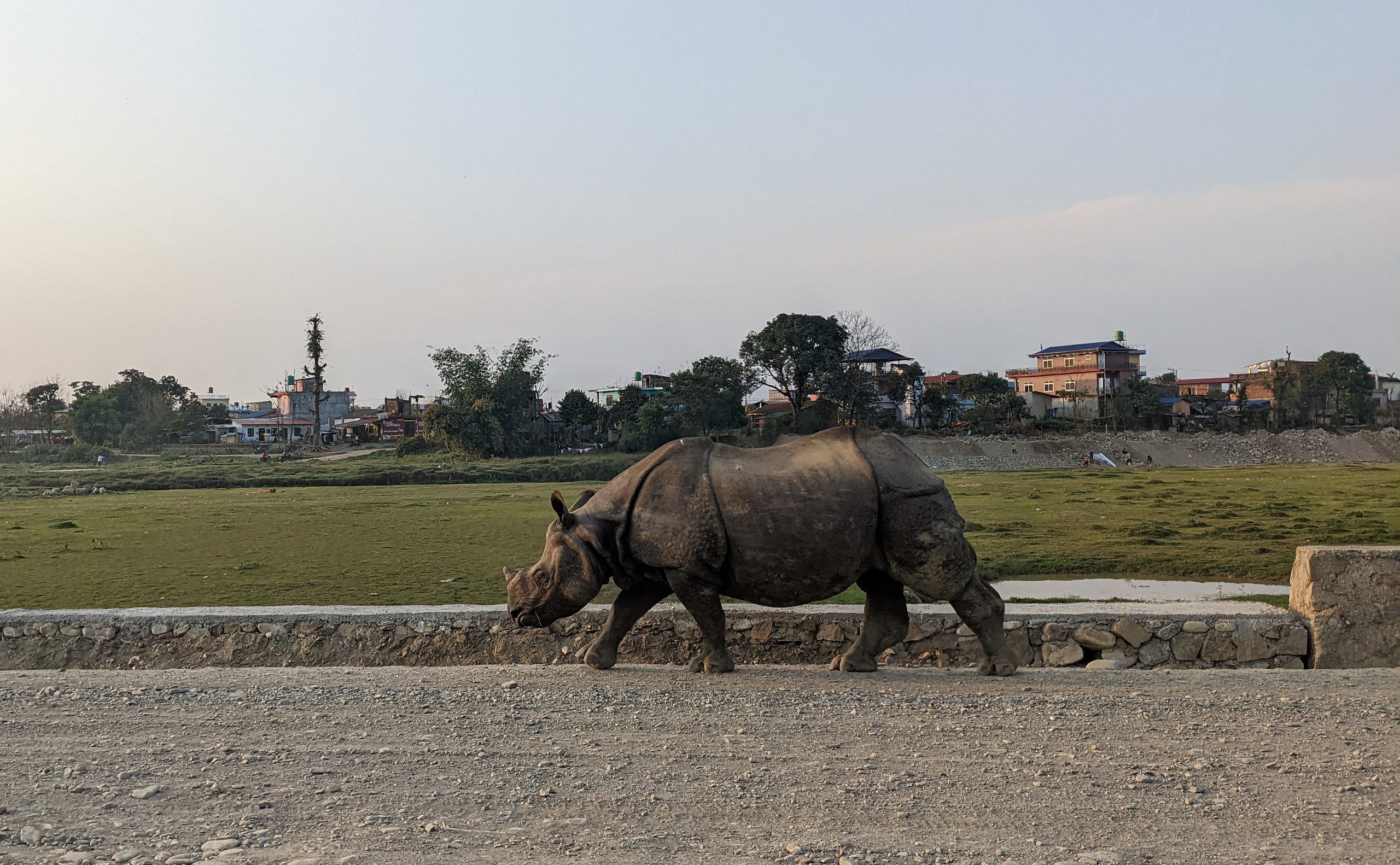Feature image: A majestic greater one-horned rhino walks on the road in Chitwan National Park, Nepal, a sight not commonly seen in areas near human settlements.
Throughout history, humans have competed with other animals for food and resources, leading to the extinction of many species worldwide. In the modern world, conflicts between humans and wildlife are increasingly common, particularly in regions like Nepal where most communities rely on subsistence farming for their livelihoods. As our population grows and wildlife adapts to our habitats, interactions between people and animals intensify, resulting in human casualties, livestock losses, crop damage and harm to wildlife.
Chitwan National Park, Nepal’s first protected area and a UNESCO World Heritage Site, frequently faces such conflicts. It is home to iconic wildlife such as the greater one-horned rhinoceros, Asian elephant and Bengal tiger, as well as indigenous communities. These indigenous groups and iconic wildlife have coexisted for centuries. However, the malaria eradication program in the 1950s, along with the conversion of wildlife habitats into agricultural lands and rapid development, increased conflicts between local communities and wildlife.
Communities in Chitwan heavily rely on subsistence farming, including livestock keeping, which unintentionally attracts wildlife. This occurs because farming practices provide readily accessible food sources: crops attract deer, whereas livestock attracts predators such as leopards. Although farmers do not intend for this to happen, the need to grow their own food and maintain livestock unintentionally creates an extended habitat for other wildlife.
Human-wildlife interactions are shaped by the unique ways in which local communities and wildlife interact with each other. Promoting coexistence in a place like Chitwan necessitates the involvement of affected communities and consideration of their needs. These locals are critical stakeholders who share resources and space with wildlife, thereby playing a pivotal role in the long-term survival of these animals.
In a recent study published in Conservation Science and Practice, we explored community-preferred policies for coexistence in Chitwan National Park. We interviewed 506 households across four park sectors and found that a majority had experienced human-wildlife conflicts in various forms over the past five years. Wildlife such as rhinos, elephants, wild boars and deer caused significant crop damage. These damages varied across different sectors of the park.
Overall, respondents favoured interventions that include enhanced livelihood diversification, cultivation of non-palatable crops, promotion of alternative livelihoods, and strengthening of rapid response teams. While 66 percent of participants view the compensation process as time-consuming, 76 percent concur that fencing effectively reduces conflicts. Through our research, we also recommend collaborating with local communities to co-design and install fences, as well as expediting compensation for crop damage. Expedited compensation for affected individuals is crucial to garner local support as it increases the tolerance of the local community towards wildlife and encourages coexistence.
Our research highlights a persistent trend of human-wildlife conflicts in Chitwan National Park, echoing global patterns. Tailored interventions are essential for coexistence in a landscape dominated by humans. This research coincides with the park’s shift toward achieving human-wildlife coexistence. While conflicts may persist in Chitwan, our findings can aid park management in reaching this goal. Additionally, this research lays the groundwork for understanding community preferences, helping researchers, conservationists and resource managers to effectively address human-wildlife conflicts in South Asia and beyond.
Further reading
Ferdin, A. E. J., C.-H. Lee, N. Dhungana, J. W. Chook, N. Baskaran and A. Pathak. 2023. Eliciting community-preferred policy alternatives for achieving workable coexistence in a human-dominated landscape: Insights from Chitwan National Park, Nepal. Conservation Science and Practice 5(11): e13026. doi.org/10.1111/csp2.13026.






